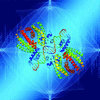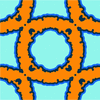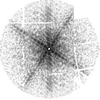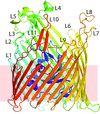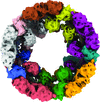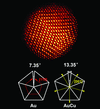issue contents
May 2019 issue

editorial
BIOLOGY | MEDICINE
The policy of IUCr Journals on diffraction data is defined.
scientific commentaries
MATERIALS | COMPUTATION
Control over the chemical composition and atomic ordering in bimetallic nanoparticles has driven the recent rapid progress in electrocatalysis. Liang & Yu [IUCrJ (2019), 6, 447–453] elucidate the structural differences between single metal and intermetallic multiply twinned decahedral nanoparticles on the example of AuCu particles and correlate the catalytic properties with their structure at the atomic level.
research papers
BIOLOGY | MEDICINE
Nanoconfinement dramatically modifies the behaviour of solvent within protein crystals, allowing biophysical measurements in the presence of liquid solvent at temperatures down to ∼200 K. When internal ice forms it is stacking-disordered, consistent with nucleation within deeply supercooled solvent, and ice does not form in solvent within ∼5 Å of the protein surface.
PHYSICS | FELS
The application of X-ray coherent diffractive imaging to structure determination of single biomolecules at free electron lasers yields signal levels down to a few hundred scattered photons per frame or less. Here we demonstrate in an analog experiment at a synchrotron source that even at a sparsity level of order 1.3 × 10−3 photons per pixel per frame the 3D structure of a nano-fabricated sample can be obtained, even if the orientation of the particle for a given individual frame is not explicitly known.
MATERIALS | COMPUTATION
A dual-phase Ni–Mn–Ga alloy, composed of an austenite matrix with stably existing martensite embryos, was designed for the experimental and theoretical investigation of the evolution of the crystallographic structure during step-wise stress-induced martensite detwinning and martensite transformation. This research provides an insight into the detwinning mechanisms of a hierarchical twinning structure and crystallographic characterization of a three-stage austenite–martensite transformation.
BIOLOGY | MEDICINE
Download citation


Download citation


Advantages of using a wavelength of 2.7 Å over a wavelength of 1.9 Å for native single-wavelength anomalous dispersion phasing are presented, and potentials of using a wavelength of 3.3 Å are discussed.
BIOLOGY | MEDICINE
Subatomic resolution X-ray structures of green fluorescent protein are reported.
BIOLOGY | MEDICINE
Download citation


Download citation


This work presents the crystal structure and functional characterization of FhuE, the bacterial outer membrane transporter responsible for the import of coprogen. Coprogen is an iron-scavenging compound produced by fungi, and FhuE allows bacteria to engage in iron piracy from fungal competitors.
PDB reference: FhuE in complex with its substrate coprogen, 6e4v
BIOLOGY | MEDICINE
This article presents the first injector-based serial crystallography experiments carried out at a pink X-ray beam source, the BioCARS beamline at the Advanced Photon Source. Microcrystals of human A2A adenosine receptor and proteinase K were screened and the structures determined to resolutions of 4.2 and 1.8 Å, respectively.
CRYO | EM
Download citation


Download citation


The cryo-EM structure of squid hemocyanin, obtained using a multi-symmetry refinement protocol in SPHIRE, reveals an unexpected breaking of fivefold symmetry in the central ring and a striking arrangement of the subunits.
PDB reference: squid hemocyanin, 6r83
CHEMISTRY | CRYSTENG
Download citation


Download citation


A detailed powder neutron diffraction study reveals that the layered perovskite ferroelectric Bi4Ti3O12 undergoes an unusual phase transition sequence, exhibiting an unexpected and unique octahedral-tilted phase above TC.
MATERIALS | COMPUTATION
The formation of multiply twinned structures in decahedral intermetallic nanoparticles has been explored and a general framework proposed to understand it.
BIOLOGY | MEDICINE
An innovative microfluidic design (ChipX3) is described for simple biomacromolecule crystallization by counter-diffusion, allowing semi-automated structural analysis by serial crystallography at room temperature. The functionalities of ChipX3 are demonstrated using case studies leading to high-resolution structures of four proteins and an RNA.
MATERIALS | COMPUTATION
Changes in the c/a ratio and the effect of uniform strain for the tetragonal transformation of X2 − xMn1 + xV (X = Pd, Ni, Pt, Ag, Au, Ir, Co; x = 1, 0) were studied. Surprisingly, all the Mn-poor alloys undergo possible tetragonal distortion and attain a stable tetragonal phase, whereas Mn-rich alloys do not have, or have only to a small extent, tetragonal distortion.
NEUTRON | SYNCHROTRON
The density and content of an amorphous component in cement pastes has been quantified by ptychography in the presence of a large amount of another different amorphous component.
NEUTRON | SYNCHROTRON
Download citation


Download citation


W-type hexaferrites were investigated by both X-ray and neutron powder diffraction along with macroscopic measurements. The refined nuclear structure and magnetic ordering are in good agreement with the measured magnetic properties, solidifying the robustness of using X-rays and neutrons in conjunction.
addenda and errata
PHYSICS | FELS
Corrigendum to the article by Daurer et al. [IUCrJ (2017). 4, 251–262.].



 journal menu
journal menu




 access
access



